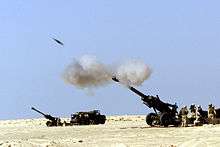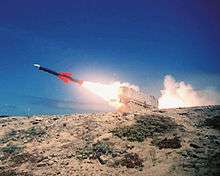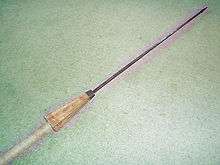Ranged weapon
A ranged weapon is any weapon that can engage targets beyond hand-to-hand distance, i.e. at distances greater than the physical reach of the weapon itself. It is sometimes also called projectile weapon or missile weapon because it typically works by launching projectiles ("missiles"), though technically a directed-energy weapon (which does not involve projectiles) is also a ranged weapon. In contrast, a weapon intended to be used in hand-to-hand combat is called a melee weapon.

Ranged weapons give the attacker an advantage in combat, since the target is often getting hit from beyond immediate visual range, and therefore has less time to react and more difficulty defending and hitting back effectively.[1] It also puts distance between the attacker and the opponent, which is a safer combat option since the close physical contact during melee combat often puts the attacker within the immediate striking range of enemy counterattack, and thus at an equal risk of getting hurt or killed.
The line between ranged and melee weapons is not entirely definite; for instance, spears, axes, knives and daggers can be used for both throwing and striking, depending on purpose and situation; and a ranged weapon can also be used as a melee weapon in close encounters, such as a rifle being used for melee with its buttstock and a fixed bayonet, handguns can be used as an improvised hammer and even an arrow can be used for stabbing in desperate situations.
Early ranged weapons often included specifically designed hand-thrown weapons such as javelins, slings and darts, as well as more complex elastic weapons such as slingshots and bows; and siege engines like stone throwers, catapults, ballistas and trebuchets. These ranged weapons were extremely effective in combat, especially when used en masse, as they gave the wielder opportunity to launch multiple rounds of attack before an enemy armed with melee weapons or shorter-ranged missile weapons could even get close enough to pose a threat.
After the invention of gunpowder and the development of firearms, gun-type pneumatic ranged weapons became the dominant weapon of choice in armed conflicts, even in close combat. In modern warfare, ranged weaponry is also used both tactically and strategically in the form of long-range artilleries, rockets and guided missiles. Maximum effective range of a weapon is the greatest distance from which the weapon can be fired while still consistently inflicting casualties or damage.
List of ranged weapons
Prehistoric and ancient period
- Hand-thrown
- Atlatl
- Bolas
- Boomerang
- Chakram
- Dart
- Hunga Munga
- Javelin / pilum
- Kestros
- Knobkierrie
- Mbanja
- Nzappa zap
- Rungu
- Sling
- Spear
- Swiss arrow
- Throwing axe
- Throwing knife
- Throwing stick
- Woomera
- Elastic
- Pneumatic
- Siege weapon
Pre-modern period

- Hand-thrown
- Pneumatic
- Rocket-propelled
- Siege weapon
- Trebuchet
- Cannon (e.g. Wuwei Bronze Cannon)
- Bombard (e.g. Faule Grete, Faule Mette, Pumhart von Steyr, Grose Bochse)
- Mortar
Early modern period
- Airgun (e.g. Girandoni air rifle)
- Musket
- Pistol
- Blunderbuss
- Musketoon
- Wall gun
- Field gun
- Culverin / demi-culverin
- Hand mortar
- Coehorn
- Zamburak
- Hwacha
- Breech-loading swivel gun
- Siege cannon (e.g. Abus Gun, Dardanelles Gun, Tsar Cannon)
Late modern/contemporary period


Most modern projectile weapons fall into the broader category of either direct fire or indirect fire, with the former often being regarded as guns and the latter as artillery. While some are small and light enough to be operated by individuals (i.e. small arms and grenade launchers), most require a team to aim, move, or fire.
- Small arms and light weapons
- Handgun
- Shotgun
- Rifled musket
- Rifle
- Single-shot rifle
- Repeating rifle (e.g. revolving rifle, carbine, battle rifle, assault rifle, etc)
- Submachine gun / personal defense weapon
- Squad automatic weapon / light machine gun
- Grenade launcher
- Rocket-propelled grenade / rocket launcher
- Shoulder-fired missile
- Crew-served weapons / heavy weapons
- Medium machine gun
- General purpose machine gun
- Heavy machine gun
- Anti-material rifle / anti-tank rifle
- Autocannon
- Recoilless rifle
- Multiple-barrel firearm
- Field artillery
- Tank gun
- Mortar
- Rocket artillery
- Guided missile
- Air-to-air missile
- Air-to-surface missile
- Anti-ship missile
- Anti-submarine rocket
- Surface-to-air missile
- Anti-satellite weapon
- Anti-tank guided missile
- Surface-to-surface missile
- Ballistic missile
- Tactical ballistic missile
- Theater ballistic missile (short-range ballistic missile, medium-range ballistic missile)
- Intermediate-range ballistic missile / long-range ballistic missile
- Intercontinental ballistic missile
- Anti-ship ballistic missile
- Submarine-launched ballistic missile
- Cruise missile
- Ballistic missile
- Torpedo
- Flamethrower
- Water cannon
Future/conceptual weapon
- High-acceleration linear motor
- Directed energy weapon
- Laser weapon
- Electrolaser
- Pulsed energy projectile
- Dazzler
- Particle-beam weapon
- Microwave weapon
- Sonic weapon
See also
- Projectile
- Trajectory of a projectile
- Siege engine
- List of artillery
- List of missiles
- List of missiles by nation
References
- McDonald, James. "Medieval Weapons". Medieval Weapons & Armour. Retrieved 22 May 2015.
Further reading
- Gray, David (2002) Bows of the World. The Lyons Press. ISBN 1-58574-478-6
- (1992) The Traditional Bowyers Bible Volume 1. The Lyons Press. ISBN 1-58574-085-3.
- (1992) The Traditional Bowyers Bible Volume 2. The Lyons Press. ISBN 1-58574-086-1.
- (1994) The Traditional Bowyers Bible Volume 3. The Lyons Press. ISBN 1-58574-087-X.
- The ballistics of the sling, Thom Richardson, Royal Armouries Yearbook, Volume 3 1998.
External links
| Wikimedia Commons has media related to Projectile weapons. |
| Look up ranged weapon in Wiktionary, the free dictionary. |
- Short Bows and Long Bows: Scaling effects in archery
- Sling Weapons The Evolution of Sling Weapons
- The Sling – Ancient Weapon
- Secrets of Lost Empires: Medieval Siege (building of and history of trebuchets), from the NOVA website
- Modern and Civil War Era Cannon Information
(Wayback Machine copy)
